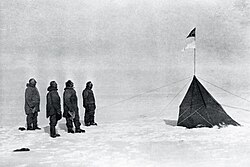Antarctica Without Ice Sheet
Isostatic rebound is the result of the weight of the ice sheet depressing the land under it. After the ice is removed, the land will rise over a period of thousands of years by an amount approximately 1/3 as high as the ice sheet that was removed (because rock is 3 times as dense as ice). Approximately half the uplift occurs during the first two thousand years. If the ice sheet is removed over more than a few thousand years, then it is possible that a majority of the uplift will occur before the ice sheet fully disappears.
As indicated in the map, Antarctica consists of a large continental region (East Antarctica) and group of seas and smaller land regions (West Antarctica). Since the West Antarctic ice sheet is partially anchored below sea level, this region is less stable and more likely to be affected by global warming. Even so, it is likely that during the next century increased precipitation over Antarctica will offset melting.
Even in the event of severe sustained warming, it would take many thousands of years for Eastern Antarctica to be fully deglaciated.Relevantní obrázky
Relevantní články
AntarktidaAntarktida je nejjižnější a nejméně obydlený kontinent na Zemi. Nachází se téměř celý jižně od Jižního polárního kruhu a je obklopen Jižním oceánem a nachází se na něm geografický jižní pól. Antarktida je pátým největším kontinentem, je asi o 40 % větší než Evropa a má rozlohu 14 200 000 km². Většinu Antarktidy pokrývá antarktický ledový příkrov o průměrné tloušťce 1,9 km. .. pokračovat ve čtení


















